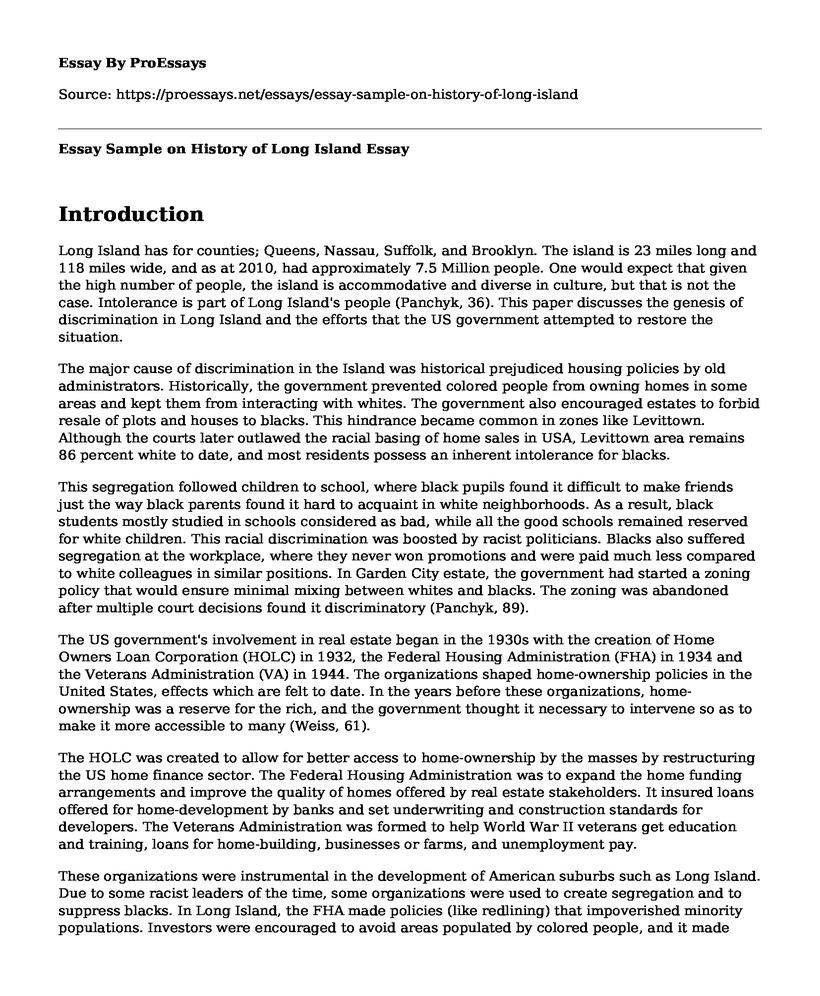Introduction
Long Island has for counties; Queens, Nassau, Suffolk, and Brooklyn. The island is 23 miles long and 118 miles wide, and as at 2010, had approximately 7.5 Million people. One would expect that given the high number of people, the island is accommodative and diverse in culture, but that is not the case. Intolerance is part of Long Island's people (Panchyk, 36). This paper discusses the genesis of discrimination in Long Island and the efforts that the US government attempted to restore the situation.
The major cause of discrimination in the Island was historical prejudiced housing policies by old administrators. Historically, the government prevented colored people from owning homes in some areas and kept them from interacting with whites. The government also encouraged estates to forbid resale of plots and houses to blacks. This hindrance became common in zones like Levittown. Although the courts later outlawed the racial basing of home sales in USA, Levittown area remains 86 percent white to date, and most residents possess an inherent intolerance for blacks.
This segregation followed children to school, where black pupils found it difficult to make friends just the way black parents found it hard to acquaint in white neighborhoods. As a result, black students mostly studied in schools considered as bad, while all the good schools remained reserved for white children. This racial discrimination was boosted by racist politicians. Blacks also suffered segregation at the workplace, where they never won promotions and were paid much less compared to white colleagues in similar positions. In Garden City estate, the government had started a zoning policy that would ensure minimal mixing between whites and blacks. The zoning was abandoned after multiple court decisions found it discriminatory (Panchyk, 89).
The US government's involvement in real estate began in the 1930s with the creation of Home Owners Loan Corporation (HOLC) in 1932, the Federal Housing Administration (FHA) in 1934 and the Veterans Administration (VA) in 1944. The organizations shaped home-ownership policies in the United States, effects which are felt to date. In the years before these organizations, home-ownership was a reserve for the rich, and the government thought it necessary to intervene so as to make it more accessible to many (Weiss, 61).
The HOLC was created to allow for better access to home-ownership by the masses by restructuring the US home finance sector. The Federal Housing Administration was to expand the home funding arrangements and improve the quality of homes offered by real estate stakeholders. It insured loans offered for home-development by banks and set underwriting and construction standards for developers. The Veterans Administration was formed to help World War II veterans get education and training, loans for home-building, businesses or farms, and unemployment pay.
These organizations were instrumental in the development of American suburbs such as Long Island. Due to some racist leaders of the time, some organizations were used to create segregation and to suppress blacks. In Long Island, the FHA made policies (like redlining) that impoverished minority populations. Investors were encouraged to avoid areas populated by colored people, and it made access to home loans and mortgages near impossible for the minorities.
Sadly also, the Veterans Association advocated more for the rights of white veterans than black ones, and still ensured minimal mixing between the two groups. Because the VA was run by white officials, most blacks never received their benefits. Even in colleges, black veterans could only be admitted at Historically Black Colleges and Universities and this lead to a strain of the institutions' resources. As a result, many black veterans got turned back and failed to access the subsidized education that the VA was to provide for them (Weiss, 97).
Conclusion
This kind of blatant segregation ensured that Long Island remained divided along racial lines. Blacks remained in their underdeveloped areas and schools and were kept as far away from whites as possible. Legislation outlawed racial biasness in public and private institutions, but in Long Island, tolerance has been difficult to fully achieve.
Works Cited
Panchyk, Richard. Hidden History of Long Island. , 2016. Print.
Weiss, Marc A. The Rise of the Community Builders: The American Real Estate Industry and Urban Land Planning. Washington, D.C: Beard Books, 2002. Print.
Cite this page
Essay Sample on History of Long Island. (2022, Nov 04). Retrieved from https://proessays.net/essays/essay-sample-on-history-of-long-island
If you are the original author of this essay and no longer wish to have it published on the ProEssays website, please click below to request its removal:
- Paper Example on Causes of World War 2
- Reflection Paper: The Plague of Athens
- Compare and Contrast Essay on Achilles and Hector
- U.S. Nuclear Policy after the Cold War Essay Example
- Research Paper on The Cold War: A Conflict That Almost Brought the World to Its Knees
- Essay Example on the Lives of Marcus Garvey and Martin Luther King
- Free Essay Sample on Body Positivity







